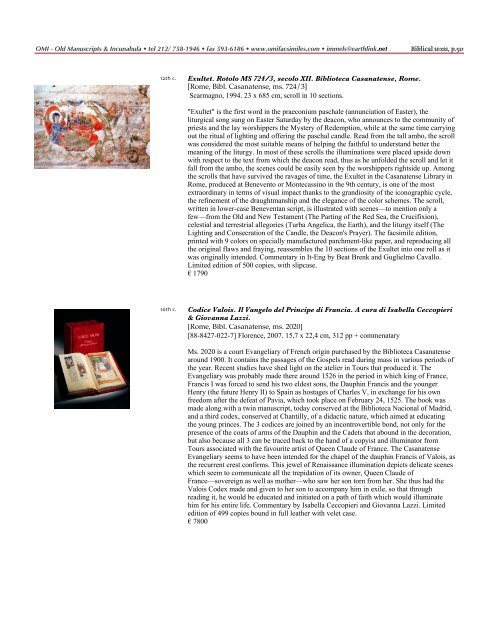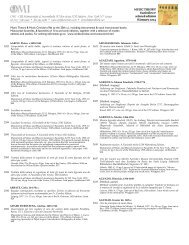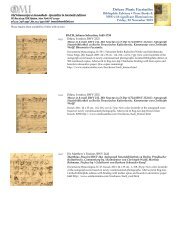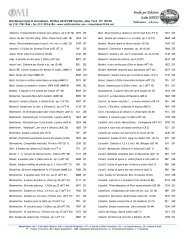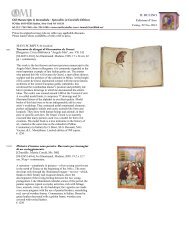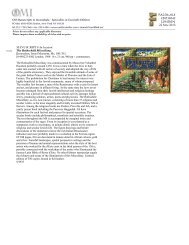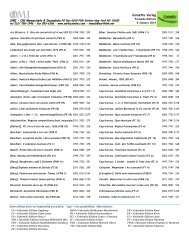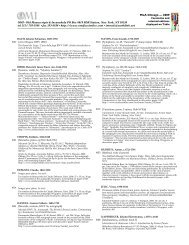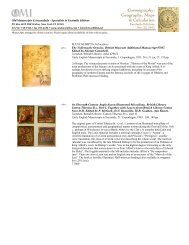Bibles & sacred texts - facsimiles - Omi
Bibles & sacred texts - facsimiles - Omi
Bibles & sacred texts - facsimiles - Omi
You also want an ePaper? Increase the reach of your titles
YUMPU automatically turns print PDFs into web optimized ePapers that Google loves.
OMI - Old Manuscripts & Incunabula • tel 212/ 758-1946 • fax 593-6186 • www.omi<strong>facsimiles</strong>.com • immels@earthlink.net Biblical <strong>texts</strong>, p.50<br />
12th c. Exultet. Rotolo MS 724/3, secolo XII. Biblioteca Casanatense, Rome.<br />
[Rome, Bibl. Casanatense, ms. 724/3]<br />
Scarmagno, 1994. 23 x 685 cm, scroll in 10 sections.<br />
"Exultet" is the first word in the praeconium paschale (annunciation of Easter), the<br />
liturgical song sung on Easter Saturday by the deacon, who announces to the community of<br />
priests and the lay worshippers the Mystery of Redemption, while at the same time carrying<br />
out the ritual of lighting and offering the paschal candle. Read from the tall ambo, the scroll<br />
was considered the most suitable means of helping the faithful to understand better the<br />
meaning of the liturgy. In most of these scrolls the illuminations were placed upside down<br />
with respect to the text from which the deacon read, thus as he unfolded the scroll and let it<br />
fall from the ambo, the scenes could be easily seen by the worshippers rightside up. Among<br />
the scrolls that have survived the ravages of time, the Exultet in the Casanatense Library in<br />
Rome, produced at Benevento or Montecassino in the 9th century, is one of the most<br />
extraordinary in terms of visual impact thanks to the grandiosity of the iconographic cycle,<br />
the refinement of the draughtmanship and the elegance of the color schemes. The scroll,<br />
written in lower-case Beneventan script, is illustrated with scenes—to mention only a<br />
few—from the Old and New Testament (The Parting of the Red Sea, the Crucifixion),<br />
celestial and terrestrial allegories (Turba Angelica, the Earth), and the liturgy itself (The<br />
Lighting and Consecration of the Candle, the Deacon's Prayer). The facsimile edition,<br />
printed with 9 colors on specially manufactured parchment-like paper, and reproducing all<br />
the original flaws and fraying, reassembles the 10 sections of the Exultet into one roll as it<br />
was originally intended. Commentary in It-Eng by Beat Brenk and Guglielmo Cavallo.<br />
Limited edition of 500 copies, with slipcase.<br />
€ 1790<br />
16th c. Codice Valois. Il Vangelo del Principe di Francia. A cura di Isabella Ceccopieri<br />
& Giovanna Lazzi.<br />
[Rome, Bibl. Casanatense, ms. 2020]<br />
[88-8427-022-7] Florence, 2007. 15,7 x 22,4 cm, 312 pp + commenatary<br />
Ms. 2020 is a court Evangeliary of French origin purchased by the Biblioteca Casanatense<br />
around 1900. It contains the passages of the Gospels read during mass in various periods of<br />
the year. Recent studies have shed light on the atelier in Tours that produced it. The<br />
Evangeliary was probably made there around 1526 in the period in which king of France,<br />
Francis I was forced to send his two eldest sons, the Dauphin Francis and the younger<br />
Henry (the future Henry II) to Spain as hostages of Charles V, in exchange for his own<br />
freedom after the defeat of Pavia, which took place on February 24, 1525. The book was<br />
made along with a twin manuscript, today conserved at the Biblioteca Nacional of Madrid,<br />
and a third codex, conserved at Chantilly, of a didactic nature, which aimed at educating<br />
the young princes. The 3 codices are joined by an incontrovertible bond, not only for the<br />
presence of the coats of arms of the Dauphin and the Cadets that abound in the decoration,<br />
but also because all 3 can be traced back to the hand of a copyist and illuminator from<br />
Tours associated with the favourite artist of Queen Claude of France. The Casanatense<br />
Evangeliary seems to have been intended for the chapel of the dauphin Francis of Valois, as<br />
the recurrent crest confirms. This jewel of Renaissance illumination depicts delicate scenes<br />
which seem to communicate all the trepidation of its owner, Queen Claude of<br />
France—sovereign as well as mother—who saw her son torn from her. She thus had the<br />
Valois Codex made and given to her son to accompany him in exile, so that through<br />
reading it, he would be educated and initiated on a path of faith which would illuminate<br />
him for his entire life. Commentary by Isabella Ceccopieri and Giovanna Lazzi. Limited<br />
edition of 499 copies bound in full leather with velet case.<br />
€ 7800


